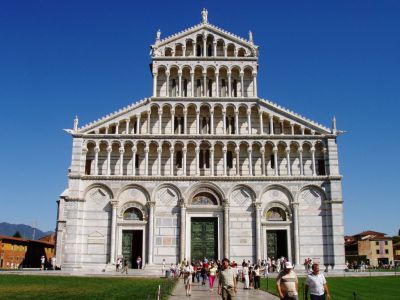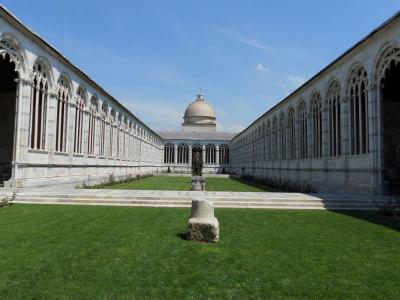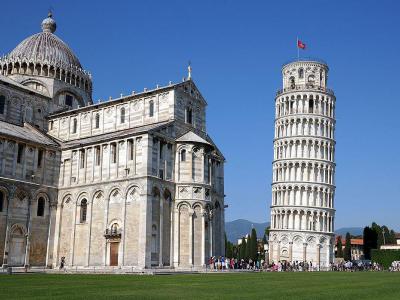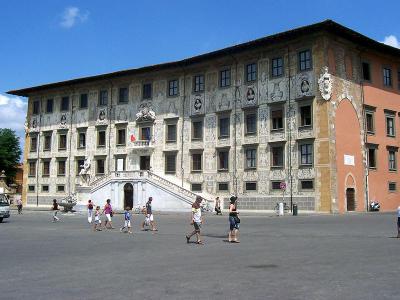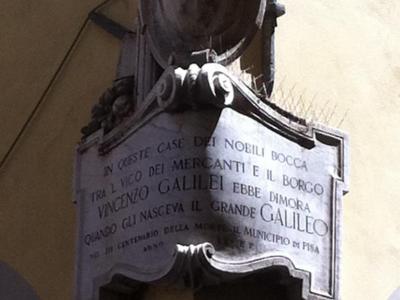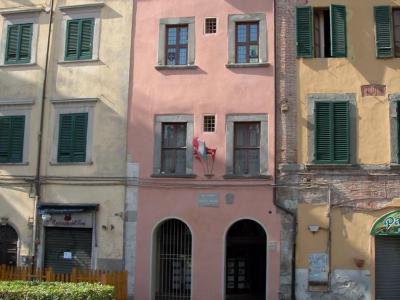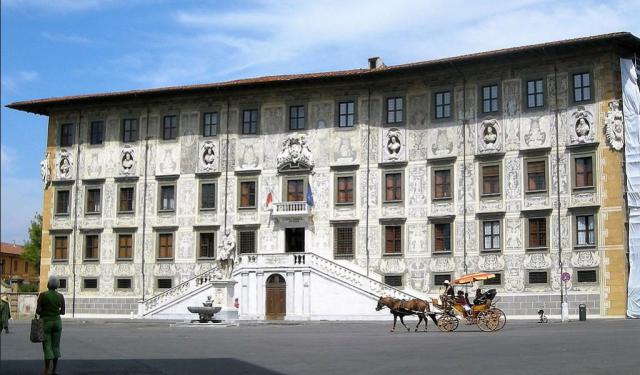
Galileo's Pisa Walking Tour (Self Guided), Pisa
Among the names that hardly need introduction there is one of Galileo Galilei. The most illustrious son of Pisa, this 16th-17th century physicist, mathematician, astronomer and philosopher went down in history as the “Father of Modern Science” and is forever cherished as one of the world’s greatest minds.
As Galileo's hometown, Pisa boasts a number of places linked to his life, of which by far not all are known even to the locals. The best starting point for the Galilean trek of Pisa is Piazza dei Miracoli. Galileo had a strong connection with this square, which, according to legend, was one of the scientific laboratories for his discoveries.
Galileo's story here began on February 19, 1564 with his christening inside the Battistero di San Giovanni – an intriguing complex built in the 12th-14th centuries. Later in his life, Galileo sensed the law of isochronism of the oscillations of the pendulum inside the Duomo (Cathedral), observing a large votive lamp. It was also from the Cathedral's Leaning Bell Tower that he conducted experiments on the fall of gravities in the presence of teachers and students of the University of Pisa – the institution in which he both studied and taught in the 1580s.
The nearby Camposanto Monumentale (Monumental Cemetery), aside from being the burial place of great scientists, houses another important Galileo memento – the afore-mentioned votive lamp.
The itinerary concludes at Casa Ammanati, the house in which Galileo was born on February 15, 1564.
If you wish to discover Pisa in the footsteps of Galileo Galilei, as both a man and a historic figure, consider spending a few hours on this self-guided walk to visit these and other places closely associated with the great scientist!
As Galileo's hometown, Pisa boasts a number of places linked to his life, of which by far not all are known even to the locals. The best starting point for the Galilean trek of Pisa is Piazza dei Miracoli. Galileo had a strong connection with this square, which, according to legend, was one of the scientific laboratories for his discoveries.
Galileo's story here began on February 19, 1564 with his christening inside the Battistero di San Giovanni – an intriguing complex built in the 12th-14th centuries. Later in his life, Galileo sensed the law of isochronism of the oscillations of the pendulum inside the Duomo (Cathedral), observing a large votive lamp. It was also from the Cathedral's Leaning Bell Tower that he conducted experiments on the fall of gravities in the presence of teachers and students of the University of Pisa – the institution in which he both studied and taught in the 1580s.
The nearby Camposanto Monumentale (Monumental Cemetery), aside from being the burial place of great scientists, houses another important Galileo memento – the afore-mentioned votive lamp.
The itinerary concludes at Casa Ammanati, the house in which Galileo was born on February 15, 1564.
If you wish to discover Pisa in the footsteps of Galileo Galilei, as both a man and a historic figure, consider spending a few hours on this self-guided walk to visit these and other places closely associated with the great scientist!
How it works: Download the app "GPSmyCity: Walks in 1K+ Cities" from Apple App Store or Google Play Store to your mobile phone or tablet. The app turns your mobile device into a personal tour guide and its built-in GPS navigation functions guide you from one tour stop to next. The app works offline, so no data plan is needed when traveling abroad.
Galileo's Pisa Walking Tour Map
Guide Name: Galileo's Pisa Walking Tour
Guide Location: Italy » Pisa (See other walking tours in Pisa)
Guide Type: Self-guided Walking Tour (Sightseeing)
# of Attractions: 7
Tour Duration: 1 Hour(s)
Travel Distance: 1.8 Km or 1.1 Miles
Author: nicole
Sight(s) Featured in This Guide:
Guide Location: Italy » Pisa (See other walking tours in Pisa)
Guide Type: Self-guided Walking Tour (Sightseeing)
# of Attractions: 7
Tour Duration: 1 Hour(s)
Travel Distance: 1.8 Km or 1.1 Miles
Author: nicole
Sight(s) Featured in This Guide:
- Duomo di Pisa (Pisa Cathedral)
- Battistero di San Giovanni (Pisa Baptistery)
- Camposanto Monumentale (Monumental Cemetery)
- The Leaning Tower
- University of Pisa
- Palazzo Bocca (Former Residence of Galileo Family)
- Birthplace of Galileo Galilei (Ammannati House)
1) Duomo di Pisa (Pisa Cathedral) (must see)
The Pisa Cathedral is the medieval cathedral that stands on the Miracles Square and it is a fine example of Italian-Romanesque architecture.
Busketo began work on the building in 1064 and his tomb is built into the façade in white stone and grey marble with colored marble discs. You will see an inscription about the foundation of the Cathedral and Pisa’s victory against the Saracens.
On the eastern end of the building there is the replica of the Pisa Griffon. The 11th century original, which is the largest known Islamic metal sculpture, can be seen in the Cathedral Museum.
The huge bronze doors were added after the original wooden ones were destroyed by fire in 1595. Above the doors are four rows of open galleries; there is a statue of the Madonna and Child and the Four Evangelists. Worshippers usually enter the church by a door built in 1180 by Pisano on the bell tower side of the cathedral.
The interior of the cathedral has black and white marble facings and the mosaics are in Byzantine style. The granite Corinthian columns come from the mosque in Palermo, which was captured by Pisa in 1063.
The gilded ceiling and frescoed dome were restored after the 1595 fire, as was the nave’s coffer ceiling. The fresco of “Christ in Majesty with the Virgin Mary and Saint John the Evangelist” luckily survived the fire and can be find in the apse.
To mark the beginning of the Pisan new year a system was devised in the cathedral whereby a beam of light shines through a round window on the south side of the nave and, precisely at noon on March 25, lands on the same spot every year: on top of a shelf affixed to a pylon on the opposite side of the church. The lamp at the center of the nave is called Galileo's lamp, because a legend says that the great scientist formulated his theory of isochronism of the pendulum while watching its oscillations from the roof of the nave. The original, however, smaller and very different than this one, is found today in the Camposanto.
Galileo Galilei was consecrated as a scientist here.
Busketo began work on the building in 1064 and his tomb is built into the façade in white stone and grey marble with colored marble discs. You will see an inscription about the foundation of the Cathedral and Pisa’s victory against the Saracens.
On the eastern end of the building there is the replica of the Pisa Griffon. The 11th century original, which is the largest known Islamic metal sculpture, can be seen in the Cathedral Museum.
The huge bronze doors were added after the original wooden ones were destroyed by fire in 1595. Above the doors are four rows of open galleries; there is a statue of the Madonna and Child and the Four Evangelists. Worshippers usually enter the church by a door built in 1180 by Pisano on the bell tower side of the cathedral.
The interior of the cathedral has black and white marble facings and the mosaics are in Byzantine style. The granite Corinthian columns come from the mosque in Palermo, which was captured by Pisa in 1063.
The gilded ceiling and frescoed dome were restored after the 1595 fire, as was the nave’s coffer ceiling. The fresco of “Christ in Majesty with the Virgin Mary and Saint John the Evangelist” luckily survived the fire and can be find in the apse.
To mark the beginning of the Pisan new year a system was devised in the cathedral whereby a beam of light shines through a round window on the south side of the nave and, precisely at noon on March 25, lands on the same spot every year: on top of a shelf affixed to a pylon on the opposite side of the church. The lamp at the center of the nave is called Galileo's lamp, because a legend says that the great scientist formulated his theory of isochronism of the pendulum while watching its oscillations from the roof of the nave. The original, however, smaller and very different than this one, is found today in the Camposanto.
Galileo Galilei was consecrated as a scientist here.
2) Battistero di San Giovanni (Pisa Baptistery) (must see)
Construction on the Pisa Baptistery began in 1152. Designer Diotisalvi signed an interior pillar with the date 1153, but the Baptistery wasn't completed until 1363.
The impressive marble Pisa Baptistery is the largest baptistery in Italy and stands at 54.86 meters (180 feet) tall, making it almost as tall as its neighbor, the Leaning Tower. The lower portion represents Romanesque styling, whereas the upper sections with pointed arches are Gothic.
Two classical columns flank the portal. The lintel has two tiers. The lower tier portrays several scenes from John the Baptist's life. The upper tier shows John the Baptist surrounded by Christ, the Madonna, and angels.
The interior features 12 columns that represent the 12 apostles. A bronze sculpture of John the Baptist stands in the center of the baptismal font. The font's three steps represent The Father, Son, and Holy Spirit. Famed astronomer and scientist Galileo was baptized here in 1564.
The pulpit was sculpted by Nicola Pisano and completed in 1260. The artistry represents a new focus on more realistic art and represents the beginning of the Italian Renaissance period.
The Pisa Baptistery was built on the same sand as the leaning tower and leans 0.6 degrees. Visitors can climb to the viewing level and look out over the Piazza dei Miracoli (Square of Miracles).
Tips:
Every half an hour, a guardian comes in to say a few words and demonstrate Pisa Baptistery's unique acoustics. This is a good time to be on the upper viewing level, as the acoustics here are impressive.
The impressive marble Pisa Baptistery is the largest baptistery in Italy and stands at 54.86 meters (180 feet) tall, making it almost as tall as its neighbor, the Leaning Tower. The lower portion represents Romanesque styling, whereas the upper sections with pointed arches are Gothic.
Two classical columns flank the portal. The lintel has two tiers. The lower tier portrays several scenes from John the Baptist's life. The upper tier shows John the Baptist surrounded by Christ, the Madonna, and angels.
The interior features 12 columns that represent the 12 apostles. A bronze sculpture of John the Baptist stands in the center of the baptismal font. The font's three steps represent The Father, Son, and Holy Spirit. Famed astronomer and scientist Galileo was baptized here in 1564.
The pulpit was sculpted by Nicola Pisano and completed in 1260. The artistry represents a new focus on more realistic art and represents the beginning of the Italian Renaissance period.
The Pisa Baptistery was built on the same sand as the leaning tower and leans 0.6 degrees. Visitors can climb to the viewing level and look out over the Piazza dei Miracoli (Square of Miracles).
Tips:
Every half an hour, a guardian comes in to say a few words and demonstrate Pisa Baptistery's unique acoustics. This is a good time to be on the upper viewing level, as the acoustics here are impressive.
3) Camposanto Monumentale (Monumental Cemetery) (must see)
The Monumental Cemetery stands at the northern edge of the Miracles Square and took its name “Monumental” to distinguish it from other later cemeteries. The cemetery is said to have been built around sacred earth brought back from Golgotha in the 12th century by the Archbishop of Pisa, Ubaldo de’Lanfranchi.
According to legend bodies buried here decay within 24 hours. The cemetery was the fourth and last building to be erected on the square and it stands on the ruins of the first Baptistery. It is an oblong shaped Gothic style building started by di Simone in 1278. Building was completed in 1464. At the beginning of its construction, it was intended to be a church, but the plans were changed after the western end was completed.
The outer wall has 43 blind arches and two doorways. Over the right-hand entrance you will see a tabernacle containing sculptures of the Virgin and Child and four Saints, created in the 14th century by Giovanni Pisano. Most of the tombs are under the arches, once there were many Roman sarcophagi, but today only 84 remain.
The building houses three chapels: the Chapel Ammannati is the oldest, dating back to 1360; the Chapel Aulla was built in 1518 and has an altar made by della Robbia; the Chapel Dal Pozzo was added in 1594.
In the Aulla chapel we can see also the original incense lamp that Galileo Galilei used for calculation of pendular movements. This lamp is the one Galileo saw inside the cathedral, now replaced by a larger more elaborate one.
In 1944 American bombing caused a fire which destroyed most of the cemetery’s marvelous frescoes. These were removed and ongoing restoration work began on them in 1954 with the intention of returning them to their original places.
According to legend bodies buried here decay within 24 hours. The cemetery was the fourth and last building to be erected on the square and it stands on the ruins of the first Baptistery. It is an oblong shaped Gothic style building started by di Simone in 1278. Building was completed in 1464. At the beginning of its construction, it was intended to be a church, but the plans were changed after the western end was completed.
The outer wall has 43 blind arches and two doorways. Over the right-hand entrance you will see a tabernacle containing sculptures of the Virgin and Child and four Saints, created in the 14th century by Giovanni Pisano. Most of the tombs are under the arches, once there were many Roman sarcophagi, but today only 84 remain.
The building houses three chapels: the Chapel Ammannati is the oldest, dating back to 1360; the Chapel Aulla was built in 1518 and has an altar made by della Robbia; the Chapel Dal Pozzo was added in 1594.
In the Aulla chapel we can see also the original incense lamp that Galileo Galilei used for calculation of pendular movements. This lamp is the one Galileo saw inside the cathedral, now replaced by a larger more elaborate one.
In 1944 American bombing caused a fire which destroyed most of the cemetery’s marvelous frescoes. These were removed and ongoing restoration work began on them in 1954 with the intention of returning them to their original places.
4) The Leaning Tower (must see)
The Leaning Tower of Pisa is the most famous freestanding bell tower in the world. It was built between 1173 and 1372 as a companion to the Pisa Cathedral.
The ground floor features a blind arcade with Corinthian columns. The second floor was added in 1178, and the tower began to sink in the soft, sandy soil. Construction was then halted for almost a century as the Republic of Pisa engaged in battles with their neighbors.
Construction restarted in 1272, and the upper floors were built with one side taller than the other to compensate for the already leaning tower. Finally, in 1319, the seventh floor was completed, and the bell tower was added in 1372.
Between 1589 and 1592, Galileo Galilei (then professor of mathematics at the University of Pisa) dropped two spheres of different masses from the Leaning Tower of Pisa to demonstrate that their time of descent was independent of their mass. Galileo discovered through this experiment that the objects fell with the same acceleration, proving his prediction true, while at the same time disproving Aristotle's theory of gravity which states that objects fall at speed proportional to their mass.
The tower has impressively survived at least four major earthquakes. The combination of the height of the tower and the soft soil helped it resist earthquake damage.
In more recent years, efforts have been made to stabilize the tower, stop it from toppling over, and keep this historic building intact as a Pisa landmark. The tower was closed from 1990-2001 to effect this stabilization. At that time, the tower was leaning at a 5.5-degree angle (4.5 meters or 15 feet).
In 1990, the bells were removed to take away some of the weight of the building. Cables were added to the third level and anchored hundreds of meters away. Counterweights were added in 1993 to keep the tower from toppling over. Engineers worked to reduce the tilt by shifting soil from underneath the tower. The tilt was reduced by 45 centimeters and matched the 1838 tilt level.
The structural interventions were so successful that the tower has been stable, and no additional leaning has occurred.
The Leaning Tower now leans by 3.97 degrees, or 3.9 meters (12 feet 10 inches). The original height of the tower was 60 meters. Today it is 56.67 meters on the high side and 55.86 meters on the low side.
Why You Should Visit:
No visit to Pisa is complete without seeing this iconic landmark in person. Don't forget your camera for cheesy "holding up the tower" photos and the view from the top.
Tips:
Visitors can climb the 251 steps and enjoy the fantastic views from the top. Children under eight are not permitted to climb. It's advisable to buy tickets in advance to this busy and popular attraction.
The ground floor features a blind arcade with Corinthian columns. The second floor was added in 1178, and the tower began to sink in the soft, sandy soil. Construction was then halted for almost a century as the Republic of Pisa engaged in battles with their neighbors.
Construction restarted in 1272, and the upper floors were built with one side taller than the other to compensate for the already leaning tower. Finally, in 1319, the seventh floor was completed, and the bell tower was added in 1372.
Between 1589 and 1592, Galileo Galilei (then professor of mathematics at the University of Pisa) dropped two spheres of different masses from the Leaning Tower of Pisa to demonstrate that their time of descent was independent of their mass. Galileo discovered through this experiment that the objects fell with the same acceleration, proving his prediction true, while at the same time disproving Aristotle's theory of gravity which states that objects fall at speed proportional to their mass.
The tower has impressively survived at least four major earthquakes. The combination of the height of the tower and the soft soil helped it resist earthquake damage.
In more recent years, efforts have been made to stabilize the tower, stop it from toppling over, and keep this historic building intact as a Pisa landmark. The tower was closed from 1990-2001 to effect this stabilization. At that time, the tower was leaning at a 5.5-degree angle (4.5 meters or 15 feet).
In 1990, the bells were removed to take away some of the weight of the building. Cables were added to the third level and anchored hundreds of meters away. Counterweights were added in 1993 to keep the tower from toppling over. Engineers worked to reduce the tilt by shifting soil from underneath the tower. The tilt was reduced by 45 centimeters and matched the 1838 tilt level.
The structural interventions were so successful that the tower has been stable, and no additional leaning has occurred.
The Leaning Tower now leans by 3.97 degrees, or 3.9 meters (12 feet 10 inches). The original height of the tower was 60 meters. Today it is 56.67 meters on the high side and 55.86 meters on the low side.
Why You Should Visit:
No visit to Pisa is complete without seeing this iconic landmark in person. Don't forget your camera for cheesy "holding up the tower" photos and the view from the top.
Tips:
Visitors can climb the 251 steps and enjoy the fantastic views from the top. Children under eight are not permitted to climb. It's advisable to buy tickets in advance to this busy and popular attraction.
5) University of Pisa
The University of Pisa was founded in 1343 by a Papal edict. It's the tenth oldest university in Italy and the 19th oldest in the world. The University of Pisa is also home to the Orto Botanico, the world's oldest academic botanical garden.
In 1486, the University constructed the Palazzo della Sapienza (The Building of Knowledge) in the Piazza del Granofor. A representation of a cherub above the Gate 'Dell'Abbondanza' (the Gate of Abundance) that leads to square. The cherub is now a favorite symbol of The University of Pisa.
Five popes, five Italian prime ministers, and three Nobel Laureates have come from this esteemed institution. One of the university's most famous alumni and professors was Galileo Galilei.
Galileo Galilei enrolled at the University of Pisa and sought a medical degree in the early 1580s. However, he left Pisa in 1585 without completing his medical studies.
Supported by the famous and influential Medici family, he became the Chair of Mathematics at the University of Pisa in 1589. He wrote De Motu during his time at the University of Pisa, but he never published these writings on the theory of motion. In 1592, Galileo left the University of Pisa in favor of the University of Padua.
Today, the University of Pisa remains an essential cornerstone of education and continues the tradition of preparing tomorrow's leaders.
In 1486, the University constructed the Palazzo della Sapienza (The Building of Knowledge) in the Piazza del Granofor. A representation of a cherub above the Gate 'Dell'Abbondanza' (the Gate of Abundance) that leads to square. The cherub is now a favorite symbol of The University of Pisa.
Five popes, five Italian prime ministers, and three Nobel Laureates have come from this esteemed institution. One of the university's most famous alumni and professors was Galileo Galilei.
Galileo Galilei enrolled at the University of Pisa and sought a medical degree in the early 1580s. However, he left Pisa in 1585 without completing his medical studies.
Supported by the famous and influential Medici family, he became the Chair of Mathematics at the University of Pisa in 1589. He wrote De Motu during his time at the University of Pisa, but he never published these writings on the theory of motion. In 1592, Galileo left the University of Pisa in favor of the University of Padua.
Today, the University of Pisa remains an essential cornerstone of education and continues the tradition of preparing tomorrow's leaders.
6) Palazzo Bocca (Former Residence of Galileo Family)
A plaque at Palazzo Bocca commemorates the time that the Galilei family lived on the corner of Borgo Stretto and via Mercanti. The Galileo family settled here from 1563 to 1574.
Visitors can admire Palazzo Bocca's gorgeous facade and walk Borgo Stretto, one of Pisa's oldest streets. Borgo Stretto is well known as one of Pisa's top shopping streets.
Visitors will also find Palazzo Bocca is located in the historic center of Pisa. From here, Galileo was just a stone's throw from the Square of Miracles and many impressive religious and cultural landmarks.
Visitors can admire Palazzo Bocca's gorgeous facade and walk Borgo Stretto, one of Pisa's oldest streets. Borgo Stretto is well known as one of Pisa's top shopping streets.
Visitors will also find Palazzo Bocca is located in the historic center of Pisa. From here, Galileo was just a stone's throw from the Square of Miracles and many impressive religious and cultural landmarks.
7) Birthplace of Galileo Galilei (Ammannati House)
Galileo Galilei was born in 1564. Modern scholars have identified what they believe to be his birthplace, the Ammannati House, named after Galileo's mother's maiden name.
In 1864, as part of the 300th-anniversary celebrations of Galileo's birth, historians identified a home near the church of the Fortress as Galileo's birthplace. However, historians had not taken into account that only children of soldiers were born in this area.
More recently, scholars re-examined historical documents and believe Galileo was born on Via Giusti in a home belonging to his mother, Giulia Ammannati.
In 2020, a bronze statue of Galileo Galilei was placed in Largo Ciro Menotti, just a stone's throw from the famous scientist's childhood home. The house is not open to the public, but this is an important landmark in Pisa.
Gabriele Vicari is the sculptor behind this inspired work. Instead of being represented as an older man, this sculpture represents Galileo in the prime of his life. He stands with a telescope and a celestial sphere.
In 1864, as part of the 300th-anniversary celebrations of Galileo's birth, historians identified a home near the church of the Fortress as Galileo's birthplace. However, historians had not taken into account that only children of soldiers were born in this area.
More recently, scholars re-examined historical documents and believe Galileo was born on Via Giusti in a home belonging to his mother, Giulia Ammannati.
In 2020, a bronze statue of Galileo Galilei was placed in Largo Ciro Menotti, just a stone's throw from the famous scientist's childhood home. The house is not open to the public, but this is an important landmark in Pisa.
Gabriele Vicari is the sculptor behind this inspired work. Instead of being represented as an older man, this sculpture represents Galileo in the prime of his life. He stands with a telescope and a celestial sphere.
Walking Tours in Pisa, Italy
Create Your Own Walk in Pisa
Creating your own self-guided walk in Pisa is easy and fun. Choose the city attractions that you want to see and a walk route map will be created just for you. You can even set your hotel as the start point of the walk.
Pisa Introduction Walking Tour
The city of Pisa, in Italy's Tuscany region, is best known worldwide for its iconic Leaning Tower, as well as for being the birthplace of Galileo Galilei, whom considered by many as the Father of Modern Science.
The origin of the name Pisa is a mystery, while the origin of the city itself – as Etruscan – was confirmed only in 1991.
Founded on the seashore (which had since moved... view more
Tour Duration: 2 Hour(s)
Travel Distance: 3.0 Km or 1.9 Miles
The origin of the name Pisa is a mystery, while the origin of the city itself – as Etruscan – was confirmed only in 1991.
Founded on the seashore (which had since moved... view more
Tour Duration: 2 Hour(s)
Travel Distance: 3.0 Km or 1.9 Miles
Pisa Palaces Walking Tour
As you continue your acquaintance with Pisa, you will notice that there is a lot more to see here than just a "leaning" landmark. Indeed, just like Italy in general, this particular Tuscan city boasts a glorious heritage of wonderful palaces, fit to transport you back in time.
The most beautiful palaces in Pisa are found on both sides of the Arno River, forming a multi-colored ribbon... view more
Tour Duration: 1 Hour(s)
Travel Distance: 2.1 Km or 1.3 Miles
The most beautiful palaces in Pisa are found on both sides of the Arno River, forming a multi-colored ribbon... view more
Tour Duration: 1 Hour(s)
Travel Distance: 2.1 Km or 1.3 Miles
The Most Popular Cities
/ view all
